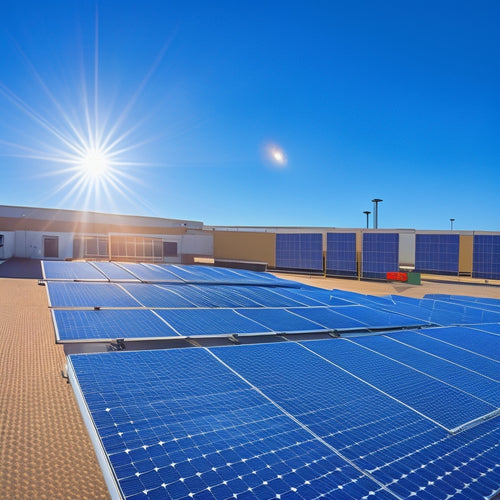
Lithium Ion Energy Storage in Renewable Energy
Share
Lithium-ion energy storage is essential for enhancing renewable energy systems through its high energy density and cost-effectiveness. It offers 150-250 Wh/kg, enabling you to manage variable sources like solar and wind efficiently. As prices decline and lifespan improves, these batteries become a smart long-term investment. You'll find that they support effective energy management strategies, allowing real-time consumption adjustments. Their scalability guarantees you can expand capacity easily as your needs grow. By comprehending factors influencing battery performance and durability, you can optimize your energy storage solutions. Investigate further to uncover more understandings on maximizing your renewable energy capabilities.
At a Glance
- Lithium-ion batteries offer high energy density (150-250 Wh/kg), making them ideal for compact renewable energy applications like solar and wind systems.
- The decreasing cost of lithium-ion batteries enhances their cost-effectiveness, supporting sustainable financial models for renewable energy initiatives.
- Enhanced lifespan from technological advancements reduces maintenance costs and replacement frequency, ensuring long-term viability in energy storage solutions.
- Effective energy management and scalability of lithium-ion systems facilitate integration with renewable sources, optimizing storage and distribution.
- Innovations in charging technologies reduce recharge times and improve efficiency, further enhancing the usability of lithium-ion energy storage in renewables.
High Energy Density Advantage
When you consider energy density, you're looking at the amount of energy stored in a given volume or mass of a battery.
Lithium-ion technology excels in this area, making it a preferred choice for renewable energy applications where space and weight are critical factors.
This high energy density allows for higher capacity batteries to be installed in smaller spaces, making them ideal for urban environments.
Understanding this advantage is essential for optimizing energy storage solutions in solar and wind systems.
Energy Density Explained
High energy density plays an indispensable role in the effectiveness of lithium-ion energy storage systems, allowing them to pack more energy into smaller, lighter packages. This advantage translates directly to higher energy capacity, which is vital for applications where size and weight are limiting factors.
When you're evaluating performance metrics, energy density becomes a key indicator of how well a battery can meet your needs without excessive bulk.
Lithium-ion batteries typically exhibit energy densities ranging from 150 to 250 Wh/kg, markedly outperforming other battery technologies like lead-acid or nickel-cadmium variants. This high energy density means that you can achieve longer operational times and greater efficiency, particularly in renewable energy applications where space is at a premium.
In practical terms, a battery with high energy density allows you to store more energy without increasing the physical dimensions of the system. This is particularly beneficial in mobile applications, electric vehicles, and off-grid renewable installations.
Ultimately, understanding energy density and its implications on energy capacity and performance metrics can enable you to make informed decisions when selecting energy storage solutions that align with your pursuit of freedom and sustainability.
Applications in Renewables
The advantages of high energy density in lithium-ion batteries markedly enhance their applications in renewable energy systems. With their ability to store significant amounts of energy in a compact form, these batteries facilitate effective grid integration, ensuring that renewable energy sources like solar and wind can meet fluctuating demand.
This renewable collaboration is essential for energy management strategies that optimize storage and distribute energy efficiently.
As you examine storage optimization, you'll find that lithium-ion systems enable demand response initiatives, allowing for real-time adjustments based on consumption patterns.
Their inherent system scalability means you can expand capacity as needed, catering to growing energy needs without extensive infrastructure upgrades.
Moreover, technology advancements continually improve these batteries, enhancing sustainability metrics and reducing their environmental impact.
However, be aware of regulatory challenges that may arise as you implement these systems, as adherence to developing standards is critical for long-term success.
Cost-Effective Long-Term Investment
As battery prices continue to decrease, investing in lithium-ion energy storage becomes increasingly attractive.
The energy density of lithium-ion batteries enhances their capacity to store power efficiently, making them an ideal choice for solar systems.
You'll find that the enhanced lifespan of these batteries further contributes to their cost-effectiveness over time.
This combination not only supports renewable energy initiatives but also guarantees a sustainable financial model for energy storage solutions.
Decreasing Battery Prices
Driven by advancements in technology and increased production capacity, lithium-ion battery prices have steadily decreased over the past decade. This trend is reshaping the renewable energy environment, making energy storage solutions more accessible and affordable.
As you analyze market trends, you'll notice a clear path of declining costs, influenced by economies of scale and innovations in battery chemistry.
Price forecasts indicate that this downward trend will likely continue, fueled by intensifying competition among manufacturers and ongoing research and development.
The implications for energy independence are significant; as prices drop, the initial investment barrier diminishes, enabling more individuals and businesses to adopt renewable energy systems paired with effective energy storage.
This shift not only promotes sustainability but also enables you to make choices that align with your values of freedom and independence from traditional energy sources.
Enhanced Lifespan Benefits
With advancements in battery technology, lithium-ion batteries now offer enhanced lifespan benefits that translate into a cost-effective long-term investment.
These improvements stem from superior thermal management systems that regulate temperature fluctuations, ensuring ideal operating conditions. By maintaining optimal temperatures, you can considerably enhance cycle stability, allowing your batteries to endure more charge-discharge cycles without degrading.
This increased cycle stability not only extends the lifespan of your batteries but also reduces the frequency of replacements, leading to lower overall costs. You'll find that investing in high-quality lithium-ion batteries pays off over time, as their longevity minimizes the need for ongoing capital expenditures.
Additionally, many manufacturers now provide warranties that reflect this enhanced lifespan, giving you peace of mind about your investment.
When you factor in the reduced maintenance and replacement costs, it becomes clear that these batteries represent a smart choice for energy storage solutions.
Battery Lifecycle and Durability
Understanding the battery lifecycle is essential for maximizing performance and efficiency in energy storage.
Factors such as temperature and charge cycles greatly affect durability and longevity, especially when considering the benefits of lithium-ion batteries in off-grid applications.
Lifecycle Phases Explained
As lithium-ion batteries undergo various lifecycle phases, their performance and durability greatly impact the efficiency of renewable energy systems. The lifecycle begins with production methods, where material sourcing is essential for optimizing both cost and environmental impact. Advanced techniques in manufacturing can enhance safety standards, reducing risks associated with battery failure.
During operation, performance metrics are significant to assess how batteries interact with renewable energy sources. As market trends shift towards increased adoption of electric vehicles and grid storage, understanding these metrics becomes imperative.
When batteries reach the end of their usable life, recycling processes play a meaningful role. Efficient recycling not only mitigates environmental impact but also recovers important materials, therefore supporting a sustainable supply chain.
Technological advancements in recycling can further improve this phase, providing economic benefits and aligning with policy implications that promote circular economy practices.
Each lifecycle phase is interconnected, influencing the overall effectiveness of lithium-ion batteries in renewable energy applications. By staying informed on these aspects, you can contribute to the ongoing evolution of energy storage systems that support a sustainable future.
Factors Affecting Durability
The durability of lithium-ion batteries in renewable energy systems hinges on several vital factors throughout their lifecycle.
First, temperature effects play an essential role; extreme heat or cold can accelerate degradation, impacting overall performance. You should monitor ambient conditions to guarantee peak operation.
Next, consider charge cycles. Frequent deep discharges and rapid charging can lead to capacity loss over time. Adopting moderate usage patterns can greatly extend battery life.
Material composition also matters; high-quality components resist wear better and enhance durability.
Regular maintenance practices are important. Keep terminals clean and check for corrosion, as these issues can impair functionality.
Additionally, understanding the environmental impact of your batteries is vital; proper disposal and recycling can mitigate potential harm, promoting a more sustainable lifecycle.
Selecting Based on Capacity Requirements
When selecting a lithium-ion battery, you must first assess your energy needs to determine the required capacity.
A thorough evaluation of your system's energy demands is crucial, as it helps to identify whether you'll prioritize energy density or power output for peak performance.
Understanding these factors guarantees you choose a battery that ideally meets your renewable energy goals, especially considering the benefits of advanced battery management systems.
Assessing Energy Needs
How do you determine the right capacity for lithium-ion energy storage in renewable energy systems? Start by analyzing your energy consumption patterns and engaging in demand forecasting. This helps you predict future energy needs and align them with your storage capabilities.
To simplify your assessment, consider the following table:
| Factor | Description | Importance |
|---|---|---|
| Energy Consumption | Average daily energy use across seasons | Establishes baseline |
| Peak Demand | Highest energy need during specific times | Guides storage capacity |
| Forecasted Growth | Anticipated increase in energy needs | Informs long-term planning |
Capacity vs. Application
Understanding your energy needs sets the stage for selecting the right lithium-ion storage capacity tailored to specific applications. You must engage in effective capacity planning to guarantee your energy system meets the demands of various scenarios, whether it's for residential use, commercial purposes, or grid stabilization.
Start by evaluating how much energy you require during peak and off-peak hours. This data will guide you in determining the ideal capacity that aligns with your usage patterns.
Application optimization is vital here; different use cases necessitate distinct capacities. For instance, if you're powering a home, you might prioritize short bursts of high energy, while a commercial facility might require sustained energy over longer periods.
Consider the trade-offs between capacity and performance. Too little capacity can lead to insufficient energy supply, while excessive capacity can inflate costs unnecessarily.
Faster Charging Capabilities
As you investigate faster charging capabilities, consider how enhanced charging technologies are reshaping energy storage.
These advancements considerably reduce charging times, allowing for more efficient energy use in renewable systems.
Enhanced Charging Technologies
Enhanced charging technologies are revolutionizing the way lithium-ion batteries integrate with renewable energy systems, allowing for faster charging capabilities that can greatly reduce downtime.
By implementing smart charging solutions, you can optimize charging efficiency and adapt to varying user behavior, guaranteeing that energy resources are employed effectively.
Rapid charging methods are emerging, considerably shortening the time it takes to recharge batteries while maintaining their longevity.
Wireless charging is also gaining traction, offering seamless integration into charging infrastructure, minimizing wear and tear on physical connectors.
Adaptive charging systems further enhance grid integration by adjusting charging rates based on real-time demands and energy availability, which helps to balance supply and demand on the grid.
As charging networks evolve, embracing standardized protocols will guarantee compatibility and reliability across different platforms, making it easier for you to access fast charging options wherever you go.
Incorporating these advanced charging technologies not only enhances user experience but also propels the adoption of renewable energy sources, laying the groundwork for a sustainable future.
As you investigate these innovations, you'll find that the freedom to charge quickly and efficiently is at your fingertips.
Frequently Asked Questions
What Environmental Impacts Are Associated With Lithium Ion Battery Production?
When you consider lithium extraction, it's crucial to note significant environmental impacts, such as water depletion and habitat destruction. Additionally, the entire battery lifecycle poses challenges, including recycling difficulties and toxic waste generation during production and disposal.
How Do Lithium Ion Batteries Compare to Other Energy Storage Technologies?
You'd think all energy storage technologies are equal, but lithium-ion batteries shine with their high energy density and superior charge cycles. While alternatives exist, they often can't match this efficiency, leaving you with fewer choices.
What Recycling Options Exist for Lithium Ion Batteries?
You've got several recycling processes for lithium ion batteries, including mechanical separation and hydrometallurgical methods. These techniques enhance resource recovery, reclaiming precious materials like lithium and cobalt, which supports sustainability and reduces environmental impact.
Are There Safety Concerns Regarding Lithium Ion Batteries?
Imagine a fire igniting from a single spark; that's thermal runaway in batteries. You need to prioritize battery management systems to mitigate risks, ensuring safety while enjoying the freedom these powerful energy sources provide.
How Does Temperature Affect Lithium Ion Battery Performance?
Temperature affects lithium-ion battery performance notably; higher temperatures can enhance efficiency, but excessive heat may lead to degradation. For performance optimization, maintaining an ideal temperature range is essential to prolong battery life and guarantee reliable operation.
Explore More
Incorporating lithium-ion energy storage into renewable energy systems isn't just a smart move; it's a transformative solution. With their high energy density, cost-effectiveness, and durability, these batteries meet a variety of capacity needs while enabling faster charging. By investing in this technology, you're not just keeping up with the times; you're staying ahead of the curve. As renewable energy continues to expand, leveraging lithium-ion storage will guarantee you're always ready to power your future.
Related Posts
-

The Future of Residential Energy Storage
The future of residential energy storage looks promising and cost-effective for you. With lithium-ion battery prices ...
-

Essential Solar Panel Mounts for Commercial Properties
When it comes to essential solar panel mounts for your commercial property, durability and wind resistance are key fa...
-

Top Solar Powered Camping Fans for Camping Enthusiasts
If you're a camping enthusiast, a solar-powered fan can be a transformative element for your outdoor experience. Thes...


